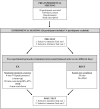Acute aerobic exercise benefits allocation of neural resources related to selective attention
- PMID: 37244926
- PMCID: PMC10220342
- DOI: 10.1038/s41598-023-35534-5
Acute aerobic exercise benefits allocation of neural resources related to selective attention
Abstract
A single session of aerobic exercise has been shown to potentially benefit subsequent performance in a wide range of cognitive tasks, but the underlying mechanisms are still not fully understood. In this study, we investigated the effects of exercise on selective attention, a cognitive process that involves prioritized processing of a subset of available inputs over others. Twenty-four healthy participants (12 women) underwent two experimental interventions in a random, crossover, and counterbalanced design: a vigorous-intensity exercise (60-65% HRR) and a seated rest (control) condition. Before and after each protocol, participants performed a modified selective attention task that demanded attending stimuli of different spatial frequencies. Event-related magnetic fields were concurrently recorded using magnetoencephalography. The results showed that exercise, relative to the seated rest condition, reduced neural processing of unattended stimuli and increased processing of attended stimuli. The findings suggest that changes in neural processing related to selective attention may be one of the mechanisms underlying exercise-induced improvements in cognition.
© 2023. The Author(s).
Conflict of interest statement
The authors declare no competing interests.
The authors declare no competing interests.
Figures





References
-
- Hillman, C. H., Kamijo, K. & Pontifex, M. B. The Relation of ERP Indices of Exercise to Brain Health and Cognition. in Functional Neuroimaging in Exercise and Sport Sciences (eds. Boecker, H., Hillman, C. H., Scheef, L. & Strüder, H. K.) 419–446 (Springer, 2012). doi:10.1007/978-1-4614-3293-7_18.

